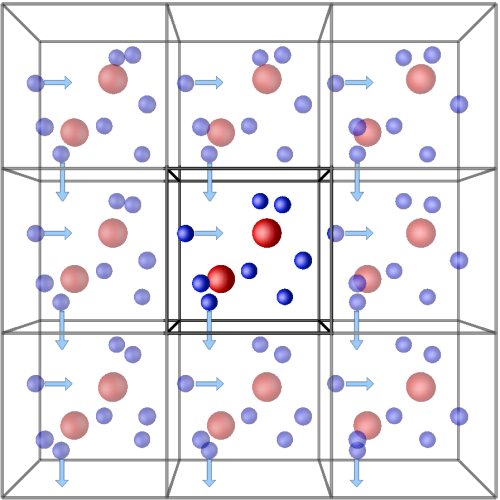Glossary
Boundary Conditions@
Periodic Boundary Conditions@
Periodic boundary conditions (PBC) are used to simulate a large (infinite) system by using a small part called a unit cell, which is a finite representative volume element of an infinite system. When an object passes through one side of the unit cell, it reappears on the opposite side. Hence, a simulation cell with PBC can be considered as being surrounded infinite number of unit cells called Images.
Coordinates of the particle that crosses the simulation box boundary, are given as
where \(x_A\) is the x-coordinate of the particle after moving, \(X_A'\) is the "image" coordinate, \(L\) us the liner size of the cell [1]
For more information please refer to wikipage on PBC

Figure.1 Schematic representation of the idea of periodic boundary conditions.(Courtsey: ISAACS Program)
Finite Boundary Conditions@
In KSOME, finite boundary conditions (FBC) can be applied to mimic the effect finite size of grain.
Absorbing Boundary Conditions@
When an object crosses the simulation box boundary then they are removed from the simulation
References@
- A. M. Ovrutsky, A. S. Prokhoda, M. S. Rasshchupkyna Computational Materials Science: Surfaces, Interfaces, Crystallization Elsevier
Defect Cluster Sizes@
Void Size@
\(\frac{4\pi}{3}R^3 = n\Omega\) after rewriting, \(R = \bigg(\frac{3n\Omega}{4\pi}\bigg)^{\frac{1}{3}}\), where \(\Omega\) = atomic volume, \(n\) = number of point-defects in the cluster or cluster size. For BCC and FCC lattices, \(\Omega\) = \(\frac{a_0^3}{2}\) and \(\frac{a_0^3}{4}\), respectively.
Loop Size@
\(\pi R^2b = n\Omega\), where \(b\) = Burgers vector. After rewriting, \(R = \Big(\frac{n\Omega}{b\pi}\Big)^{\frac{1}{2}}\).
Distance of a point from a surface@
The distance (d) of a point \(P = (x_0, y_0, z_0)\) to a plane determined by the equation \(Ax+By+Cz+D=0\) is given as in the figure below
Example
\(Z=100\) is the equation of an \(XY-\)Plane bold to \(z-\)axis at \(z=100\). For this plane, \(C=1~ \&~ D=-100\). Then the distance of the point \(P(x_0,y_0,z_0) = (5,5,5)\) from the plane is
$$ d = \frac{|0(5)+0(5)+1(5)-100|}{(0+0+1)^{½}}=95 $$
Eq. of a plane with a bold vector N = (A, B, C) and Q = (x0, y0, z0)@
The equation of the plane N is given as